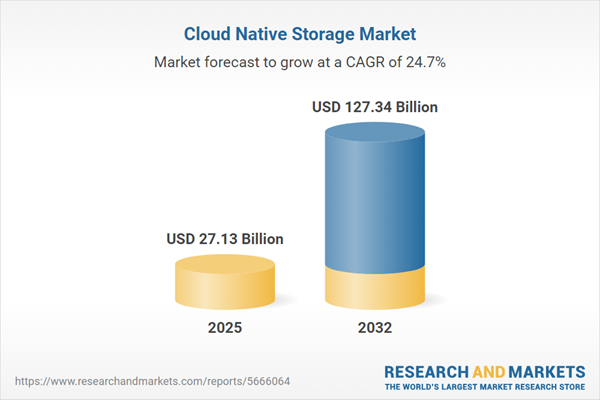Speak directly to the analyst to clarify any post sales queries you may have.
Cloud native storage is rapidly impacting the enterprise technology landscape as organizations accelerate the adoption of modern application architectures and reimagine their approach to data management and operational resilience.
Market Snapshot: Cloud Native Storage Market Growth and Prospects
The cloud native storage market expanded from USD 21.84 billion in 2024 to USD 27.13 billion in 2025, propelled by mounting demand for scalable, automated, and resilient storage solutions. With a forecasted CAGR of 24.65%, the segment is projected to reach USD 127.34 billion by 2032. Enterprise transformation, the evolution of application delivery, and increasing cost and agility requirements underpin this rapid growth. Senior decision-makers are evaluating strategic opportunities to optimize IT infrastructure, drive business agility, and ensure reliable data operations in an evolving competitive landscape.
Scope & Segmentation: Technology, Deployment, Industry, Region, and Vendor Coverage
- Product Types: Block storage (direct attached storage, SAN), file storage (distributed file systems, NAS), object storage (S3-compatible)
- Deployment Models: Hybrid cloud, multi-cloud, private cloud (Nutanix, OpenStack, VMware), and public cloud (Alibaba Cloud, Amazon Web Services, Google Cloud Platform, Microsoft Azure)
- End User Industries: Banking, financial services and insurance, healthcare, IT and telecom, manufacturing, retail
- Applications: Backup and recovery, big data and analytics, containerized environments, data archiving, DevOps automation
- Organization Sizes: Large enterprises, small and medium enterprises
- Regional Coverage: Americas (United States, Canada, Mexico, Brazil, Argentina, Chile, Colombia, Peru), Europe, Middle East & Africa (United Kingdom, Germany, France, Russia, Italy, Spain, Netherlands, Sweden, Poland, Switzerland, United Arab Emirates, Saudi Arabia, Qatar, Turkey, Israel, South Africa, Nigeria, Egypt, Kenya), Asia-Pacific (China, India, Japan, Australia, South Korea, Indonesia, Thailand, Malaysia, Singapore, Taiwan)
- Leading Vendors: Amazon Web Services, Microsoft Corporation, Google LLC, IBM Corporation, Dell Technologies, VMware, NetApp, Pure Storage, Nutanix, Red Hat
Key Takeaways for Senior Decision-Makers
- Cloud native storage directly supports organizational agility by enabling automated, policy-driven provisioning, dynamic scaling, and seamless integration with containerized application pipelines.
- The transition to software-defined architectures fosters innovation and greater performance, while open standards such as the Container Storage Interface encourage interoperability among hyperscale, enterprise, and open-source vendors.
- Industry-specific priorities, such as compliance in banking or real-time analytics in manufacturing and retail, are increasingly addressed through customizable and modular storage solutions.
- Collaboration among global hyperscalers, regional system integrators, and storage specialists enhances digital infrastructure flexibility and enables tailored service models aligned with local regulatory mandates.
- The convergence of edge computing, IoT analytics, and 5G network rollouts in regions like Asia-Pacific accelerates the deployment of innovative cloud native storage solutions.
- Automation, integration with DevOps workflows, and robust security are central enablers for achieving reliability and resilience across complex, distributed storage environments.
Tariff Impact and Supply Chain Adaptation
The 2025 introduction of revised United States trade tariffs has driven up costs for storage hardware components, prompting vendors to re-align their manufacturing strategies and encourage a shift to software-defined storage models. These market adjustments have also accelerated research into modular architectures and fostered new strategic partnerships. Enterprises are increasingly prioritizing supply chain resilience, while service providers adapt pricing, source diversification, and local assembly practices to manage cost pressures.
Methodology & Data Sources
The findings in this report draw from a combination of primary and secondary research. In-depth interviews with storage architects and IT leaders supplement a review of white papers, vendor documentation, and public filings. Data triangulation, quantitative benchmarking, and independent validation ensure the accuracy and reliability of insights and projections.
Why This Report Matters: Actionable Insights for Cloud Native Storage Strategy
- Enables IT leaders to benchmark organizational storage strategies against transformation trends, technology innovations, and regional adoption drivers.
- Informs cost optimization, resource allocation, and risk management decisions in light of evolving regulatory and supply chain dynamics.
- Provides a reliable evidence base for evaluating partner ecosystems, technology investments, and storage platform modernization initiatives.
Conclusion
Strategic adoption of cloud native storage solutions empowers businesses to achieve scalable, resilient, and cost-efficient digital infrastructure. This report equips stakeholders with the insights needed to align technology decisions with evolving business and regulatory demands, supporting sustained organizational growth and competitive advantage.
Additional Product Information:
- Purchase of this report includes 1 year online access with quarterly updates.
- This report can be updated on request. Please contact our Customer Experience team using the Ask a Question widget on our website.
Table of Contents
3. Executive Summary
4. Market Overview
7. Cumulative Impact of Artificial Intelligence 2025
Companies Mentioned
The companies profiled in this Cloud Native Storage market report include:- Amazon Web Services, Inc.
- Microsoft Corporation
- Google LLC
- IBM Corporation
- Dell Technologies Inc.
- VMware, Inc.
- NetApp, Inc.
- Pure Storage, Inc.
- Nutanix, Inc.
- Red Hat, Inc.
Table Information
| Report Attribute | Details |
|---|---|
| No. of Pages | 181 |
| Published | November 2025 |
| Forecast Period | 2025 - 2032 |
| Estimated Market Value ( USD | $ 27.13 Billion |
| Forecasted Market Value ( USD | $ 127.34 Billion |
| Compound Annual Growth Rate | 24.6% |
| Regions Covered | Global |
| No. of Companies Mentioned | 11 |









